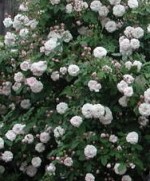 Noisettes are America’s claim to fame in the rose world. They are the only old garden rose that originated in the United States. The story goes that about 1811, John Champneys, a South Carolina rice planter, crossed a musk rose, Rosa moschata, with a china, maybe ‘Old Blush’ and produced a climber, ‘Champneys’ Pink Cluster. The flowers were small, pale pink, and borne in loose clusters. Champneys gave seedlings of this rose to his friend, Phillippe Noisette, who sent seeds of this rose to his brother, Phillip, who lived in France. Phillip bred the rose and produced several new roses and thus began the class of noisette roses. Later breeding efforts resulted in tea-noisettes that had larger flowers but less hardiness.
Noisettes are America’s claim to fame in the rose world. They are the only old garden rose that originated in the United States. The story goes that about 1811, John Champneys, a South Carolina rice planter, crossed a musk rose, Rosa moschata, with a china, maybe ‘Old Blush’ and produced a climber, ‘Champneys’ Pink Cluster. The flowers were small, pale pink, and borne in loose clusters. Champneys gave seedlings of this rose to his friend, Phillippe Noisette, who sent seeds of this rose to his brother, Phillip, who lived in France. Phillip bred the rose and produced several new roses and thus began the class of noisette roses. Later breeding efforts resulted in tea-noisettes that had larger flowers but less hardiness.
Noisettes are generally large and sprawling, and can be trained as climbers. Flower colors are white, pink, and yellow. They bloom continuously all year in warm climates and do especially well in the South. Lack of hardiness can be an issue, so care should be taken when planting in zones 7 or colder.
Flower Size: 1.5- 3”
Petal Number: 25-35
Flower Form: Flat
Flower Substance: Medium
Flowering: Continuous or good repeat
Fragrance: Strong
Stem: Flowers borne in clusters
Size of Bush: 7-20’ (most tall)
Disease Resistance: Good resistance to mildew and blackspot
Hardiness: Many zones 7 or 8; some zones 5 or 6
The following two noisettes are especially popular, have excellent American Rose Society ratings, and can be found at online sources.
 ‘Mme. Alfred Carriere’: Long, elegant pink buds open to large, fragrant, white flowers almost 4” across and are borne in loose clusters of 3-9. Bushes are 10-16’ tall, vigorous, disease resistant, relatively shade tolerant and hardy to zone 7. ARS rating 8.9
‘Mme. Alfred Carriere’: Long, elegant pink buds open to large, fragrant, white flowers almost 4” across and are borne in loose clusters of 3-9. Bushes are 10-16’ tall, vigorous, disease resistant, relatively shade tolerant and hardy to zone 7. ARS rating 8.9
 ‘Celine Forestier’: Dark pink buds open to pale yellow with hints of buff, pink, and apricot. The fully double flowers have quilled petals near the center and may be quartered around a green eye. Flowers are borne singly or in clusters of 3-5 and have a strong tea-like fragrance. The bush is large, and loose, with bright, glossy green leaves that occasionally succumb to mildew. ‘Celine Forestier’ can be grown as a large shrub or as a climber in zone 7 and warmer. ARS rating 8.5
‘Celine Forestier’: Dark pink buds open to pale yellow with hints of buff, pink, and apricot. The fully double flowers have quilled petals near the center and may be quartered around a green eye. Flowers are borne singly or in clusters of 3-5 and have a strong tea-like fragrance. The bush is large, and loose, with bright, glossy green leaves that occasionally succumb to mildew. ‘Celine Forestier’ can be grown as a large shrub or as a climber in zone 7 and warmer. ARS rating 8.5
The next rose is a popular tea-noisette. It is an excellent rose and can be obtained from online sources.
 ‘Lamarque’: Flowers are creamy white, lightly fragrant, and fully double with a mass of little petals in the center. They are produced in profusion, sometimes singly, more often in clusters of 3-4. The bush has bright green leaves, is healthy, thornless, and hardy to zone 8.
‘Lamarque’: Flowers are creamy white, lightly fragrant, and fully double with a mass of little petals in the center. They are produced in profusion, sometimes singly, more often in clusters of 3-4. The bush has bright green leaves, is healthy, thornless, and hardy to zone 8.
